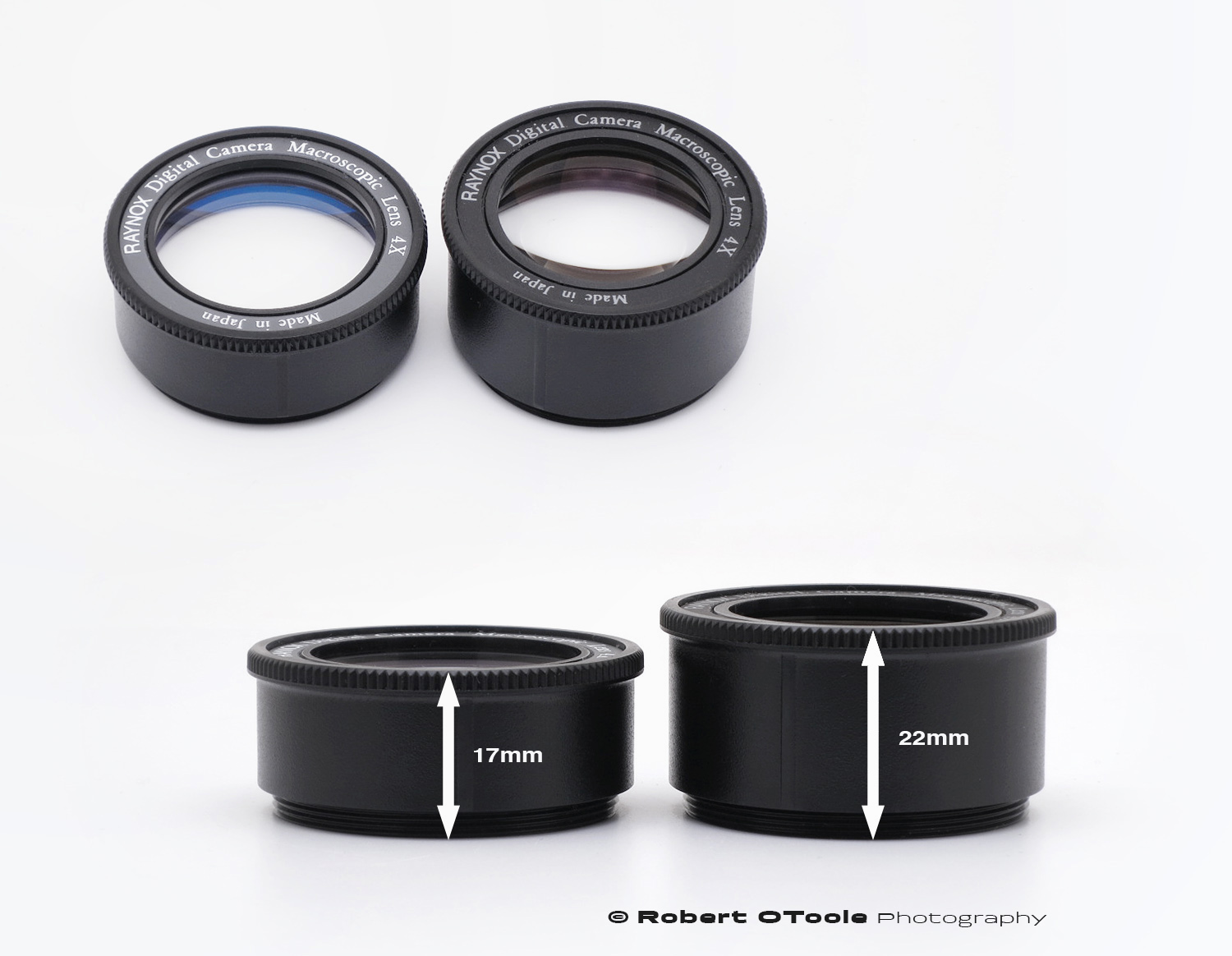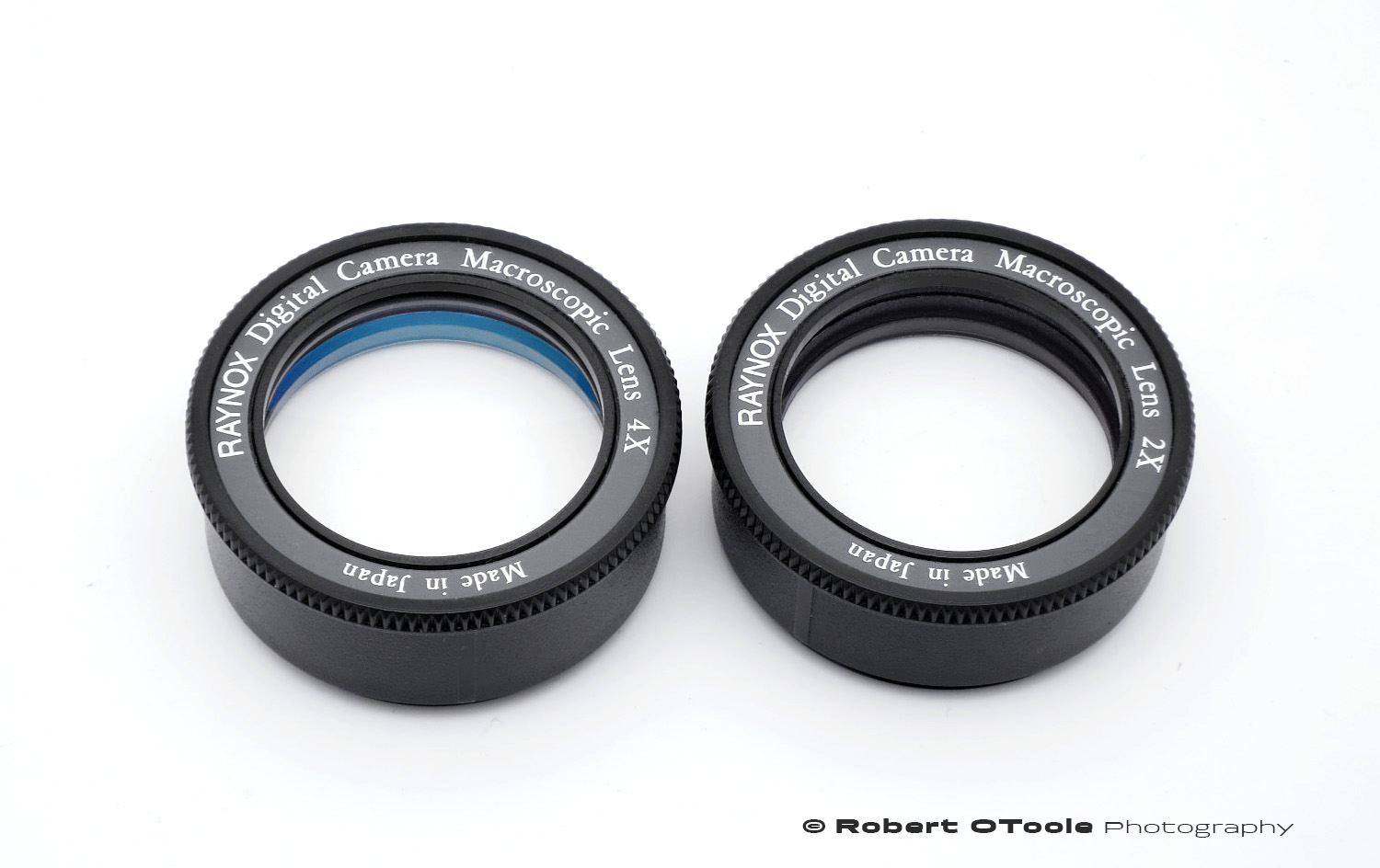What is a Raynox?
Raynox are highly corrected, 3 and 4 element achromatic multicoated lenses that are very well known for their great image quality. Don't confuse Raynox lenses with the single-element close-up filter sets that you see at your local camera shop. These little lenses are made of high index optical glass and are very sharp! These close-up lenses are designed to mount in front of a telephoto lens (or a zoom lens at the telephoto setting). A Raynox is a not a replacement for a true macro lens but, these lenses will not give you the same quality, but for the cost they perform very well and are ideal for someone that doesn't invest in a true macro lens.
A close-up lens is usually the least expensive and simplest way for someone that does not own a macro lens but would like to try photography in macro magnification territory, 1 X or life-size magnification, or higher. With a close-up lens there is no change in effective aperture, or no light loss. This gives you a nice bright viewfinder image and the ability to use wider apertures for depth of field control or higher shutter speeds if you need them. When you add a close-up lens like the Raynox to a high-quality main telephoto lens you will get added magnification with very similar image quality.
Adding extension tubes to take the lens to 1X forces the lens to focus at a distance that is outside its design which can and will usually causes chromatic and spherical aberrations, vignetting, and effective light loss. To see the increase the effective f-number with an extension tube use the formula: Effective f-stop = nominal f-stop* ( magnification + 1 ).
Teleconverters are an even worse choice than extension tubes. They are very expensive, the usually create very ugly bokeh, and they increase the effective f-number by an additional factor of whatever their power is, 1.4X or 2X. If you are at an effective f/11 at a 1 : 2 ratio, then adding a 2X teleconverter would push you to 1 : 1 but at a new effective f/22!
Which Raynox?
The two most popular Raynox lenses are the DCR-150 and DCR-250, also available as a set known as the CM-2000. The DCR-150 and DCR-250 in this set are labeled +1.5X and +2.5X lenses. Raynox supplies the lenses with a plastic 52-67mm adjustable adapter you can see in the image below.
This is the supplied Raynox adjustable adapter and DCR-150 also known as the Model M-150 lens.
The plastic Raynox adapter works okay for temporary use, it's hard to complain since it comes with the lens, but I would recommend upgrading to a metal adapter ring at some point since the plastic tabs tend to snap off after a while. An aluminum adapter like the 52mm - 43mm below, cost about $1 - $5 USD on Ebay (search term: 52mm - 43mm step down ring). Of course you would need to match the adapter to your own lenses filter threads.
Aluminum 52mm - 43mm step down ring, Raynox DCR-150 and Raynox adjustable adapter on the right.
These are two different Raynox mounting options. Raynox DCR-150 and Raynox adjustable adapter in the middle and Raynox DCR-150 with an aluminum 52mm - 43mm step down ring on the right.
RATING
Like:
Center image sharpness
Very easy to find online
Price vs performance ratio
Installation adapter included
Installs in seconds
The DCR-150 works great as a 200mm tube lens!
No change in effective aperture when using a Raynox as an add-on close-up lens
Can live with:
Plastic lens body
Disappointed with:
Corner sharpness is not as strong as the center
The non-DCR models like the MSN-202 and 505 will not cover a full frame sensor are for APS-C or smaller sensors only.
Don't need:
Raynox plastic 52-67mm adjustable adapters are really convenient but they do tend to break
Image Quality: These lenses are surprisingly sharp in the center and do okay in the corners depending on the main lens. CAs are usually pretty minimal. For the price you cant beat a Raynox for getting up to and beyond 1:1.
What you can do with a Raynox
There are two ways macro photographers use a Raynox, the most popular use is as an add-on close-up lens, where it is mounted to the front of another lens, and second, as a tube lens with an infinity-corrected microscope objective (an infinity-corrected optical system consists of two parts – the objective and the tube lens system).
Using the Raynox as a close-up lens
DCR-150 has about 8 inches (200mm) working distance, the DCR-250 focus distance is around 4 inches (100mm). Magnification depends on the lens used. The DCR-250 gives more magnification because it lets you get closer to the subject.
What magnification will you have with a Raynox?
To estimate the magnification with a Raynox and the primary lens focused at infinity, use this simple formula:
Magnification with Raynox = focal length of primary lens / focal length of the Raynox
With a 70-200mm lens @200mm and Raynox DCR-250 (focal length of DSR-250 is 125 mm, focal length of DSR-150 is 208 mm)
Mag = 200/125 or 1.6X
Lens Hood
To keep any chance of flare to a minimum I always use a lens hood on the DCR-150 and DCR-250. You can pick up an aluminum 49mm lens hood on Ebay (about $1 or $2 USD with shipping included). The 49mm hood measures 51mm at the rim but the lenses front element is only 37mm across so a 49mm hood is bigger than it needs to be. The larger hood actually makes lighting a little more difficult, so I prefer to use a 49mm - 39mm step-down ring, and a 39mm lens hood instead. The 49mm - 39mm step-down ring and a 39mm lens hood are around $1.50 to $3 each with shipping on Ebay from overseas sellers, usually located in China.
49mm hood on a Raynox DCR-150 next to another DCR-150 with 49mm to 39mm step down and 39mm hood.
Using the Raynox as a tube lens
Raynox lenses offer surprisingly good CA free and sharp image quality, when used as a tube lens. The DCR-150 works great with an infinity-corrected objective designed to be used with a 200mm tube lens.
If you use a Raynox lens as add-on close-up lenses, the DCR-250 gives more magnification because it lets you get closer to the subject, but if you use them as tube lenses, then the DCR-250 gives less magnification and a smaller image circle because it is closer to the camera. The DCR-150 is quoted as 4.8 diopter, which calculates to be 208 mm focal length. The DCR-250 is quoted as 8 diopter, which calculates to be 125 mm focal length.
Raynox Labels
Raynox labels different lenses with the same name or they label the same lens with multiple names. Here's an example.
+4.8 diopter 208mm focal length lens
On the lens itself its labeled as the Model M-150
It's more commonly called by it's part number DCR-150
The same lens is also sold as the CM-2000 1.5X (sold as part of the CM-2000 set)
The Raynox Macroscopic Lens Model M-250?
AKA the Model DCR-250
AKA the Raynox 35mm MacroExplorer Model CM-2000 2.5X,
These are all the same exact +8 diopter 125mm focal length lens.
See the list at the bottom of this page for a full list of all the lenses and various names that I have confirmed by measuring the local length of the lenses that I own.
Orientation
In certain situations a Raynox will perform better reversed mounted, mounted backwards, when using as a add-on lens or as a tube lens. Your best bet is to check your set-up for best image quality both forward and backwards.
Sensor coverage
Raynox with 43mm mounting threads will cover a full frame sensor but the 37mm threaded models are better suited for a crop sensor camera.
Raynox Close-up Lenses
Raynox Macroscopic Lens Model M-150
Also known as Model DCR-150
Also know as: Raynox 35mm MacroExplorer Model CM-2000 1.5X
+4.8 diopter
208mm focal length
43mm Mounting Threads 49mm Filter Threads
The Model M-150 (DCR-150) lenses are the same optically as the CM-200 1.5X and the Model M-250 (DCR-250) is the same as the CM-2000 2.5X. Same lenses different labels.
Raynox Macroscopic Lens Model M-250
Also known as Model DCR-250
Also know as Raynox 35mm MacroExplorer Model CM-2000 2.5X
+8 diopter
125mm focal length
43mm Mounting Threads 49mm Filter Threads
Raynox Digital Camera Macroscopic Lens 4X *
Also know as 35mm Microscopic Lens 12x model CM-3500
Also know as Raynox video microscope lens 70x
Also know as Raynox MSN-102*
+11.9 diopter
84mm focal length
37mm Mounting Threads No Filter Threads
Raynox Digital Camera Macroscopic Lens 2X
Also know as 35mm Microscopic Lens 6x model CM-3500
Also know as Raynox video microscope lens 35x
+5.9 diopter
170mm focal length
37mm Mounting Threads No Filter Threads
Raynox MSN-202**
Also know as Raynox video microscope lens 140x (VM-3000 Video MicroExplorer)
Also know as Raynox Digital Camera Macroscopic Lens 4X normal version *
Also know as Raynox MSN-102**
Also know as 35mm Microscopic Lens 24x model CM-3500
+25 diopter
40mm focal length
37mm Mounting Threads No Filter Threads
Raynox MSN-505***
+32 diopter
31mm
Metal body 37mm Mounting Threads No Filter Threads
There are two Raynox lenses labeled 4X, the shorter is a +25 diopter and the other is a +11.9 diopter
*There are two Raynox 4X lens versions that I own. One is 17mm tall and +25 diopter and the other is 22mm tall and a +11.9 diopter.
** According to Raynox, the MSN - 102 and MSN - 202 have the same "4X" label
*** This lens was not measured.
The production of MSN-200 & MSN-500 discontinued in Nov. 2005 and they were replaced by MSN-202 & MSN-505.
Raynox Close-up lens sets:
VM-3000 Video MicroExplorer Set
VM-3000 Video MicroExplorer Set
Raynox video microscope lens 35x
Raynox video microscope lens 70x
Raynox video microscope lens 140x
Raynox MSO-3030 Macro Lens Set
Raynox MSO-3030 Macro Lens Set
Raynox Digital Camera Macroscopic Lens 2X
Raynox Digital Camera Macroscopic Lens 4X +11.9 diopter type
Raynox Model CM-2000 set
Raynox 35mm MacroExplorer Model CM-2000 1.5x
Raynox 35mm MacroExplorer Model CM-2000 2.5x
Raynox model CM-3500
Raynox 35mm Microscopic Lens 6x model CM-3500
Raynox 35mm Microscopic Lens 12x model CM-3500
Raynox 35mm Microscopic Lens 24x model CM-3500
Raynox RA3734 Step-up Adapter Ring and RA3743 Step-down Adapter Ring.
Raynox adapters
Raynox makes some very useful adapters that cost only a few bucks, around $5 USD.
The RA3734 Step-up Adapter Ring drops the Raynox 37mm mounting threads down to 34mm. This will allow use with 34mm step-down rings.
The RA3743 Step-down Adapter Ring takes the Raynox 37mm mounting threads up to 43mm. This allows for installation on Schneider enlarging lenses that use 43mm filter threads, like the Schneider 80mm f/4 Componon-S enlarging lens and others.






